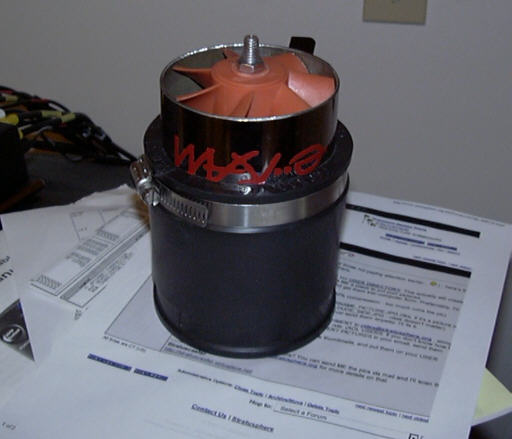|
Never Forget |
|||||||||||||||||||||||||||||||||
|
|
|||||||||||||||||||||||||||||||||
JR Body (2G Cloud)JA/JX Body (1G Cloud)MiscellaneousWaste Money Car InformationThe Society of Automotive Engineers Car EnthusiastsCar Parts Vendors |
How To Waste MoneyE-RAM Electric SuperchargerUpdated 10 February 2001: I recently got an email from the head honcho of E-Racing, maker of the E-Ram. Read his letter, and my response, here. Updated 08 February 2004: I finally performed some dyno runs using the E-Ram. You can see the pitiful results here. While the ads touting this product make a very seductive argument for buying and installing this item, the actual performance gain is so small as to be unnoticed. The E-Ram only powers up at WOT (which is when you'd want it to power up). It is supposed to give up to 1 PSIG of boost; unfortunately, it does not deliver. Before I can rip apart the ridiculous claims made by this product's vendor, I have to explain what is supposed to happen. Consider a 2.5L V-6 with a volumetric efficiency of 82%, and with peak HP at 5850 RPM. We need to find the amount of air, in cubic feet per minute (cfm), that this engine is able to pass at peak HP. Now, the displacement of the 2.5L engine (is 2.5L, but we're going to work with cfm) is 152.4 cubic inches. Using the above mentioned facts, we can figure out how much air the engine is capable of passing.
Now, we plug in numbers.
From the above formula, we find that the 2.5L V-6 is able to pass a maximum of 212 cfm at WOT. Now, the E-Ram is supposed to provide a 1 psid boost at WOT, which would be 212 cfm for the V-6. To provide this much boost for this flow rate of air, one must expend about 1 HP, or about 746 watts (W). Taking this into consideration, and assuming for the moment that the E-Ram is able to provide this boost without any mechanical or electrical losses whatsoever, the E-Ram should draw (746 W)/(13 V) = 57.4 A (amps) when it is running. However, under test, this item only draws 15.3 A, for a power draw of 199 W (0.27 HP). So, at most, the E-Ram can provide about 1/4 psig of boost, which is hardly enough to offset the HP loss just by running this thing. To compound the situation, the E-Ram actually provides a intake restriction when it's turned off (during any part-throttle response). This, in turn, requires the engine to work harder just to draw air in, which is power that could have been used instead to propel the car forward.
Flowmaster MufflerThe Flowmaster muffler was installed as an experiment to see how it would work compared to Borla's muffler. While the Flowmaster really made a good performance increase to my ride, it was also very loud and tinny. Now, loudness may not be a bad thing, as it will draw attention to your ride. Unfortunately, those who end up noticing you invariably end up to be the types who drive those really neat Also, it depends on what you're trying to aim for in a ride. If you're like me, and want to have some refinement and class while driving down the road, a really loud tinny sound kind of detracts from the whole top-down driving experience. Kind of makes me feel like I was driving a Honda. Yuck! It depends on what you want to listen to when you're driving down the road, as well. This is a pretty simple question. I, for one, would prefer listening to some good rock music over listening to exhaust noise. But then again, that's just me. The bottom line is this: The $149 spent on this Flowmaster muffler could have gone instead for a good Borla turbo muffler, Dynomax bullet-style racing muffler as a resonator, and still have some money left over. Spiral-MaxThe concept of swirl involves inducing a vortex inside either the combustion chamber or the intake manifold runners in order to have a more evenly mixed fuel-air mix once the cylinder fires. This is proven to improve engine efficiency, as well as develop more power than a similar engine without some means to develop swirl. That said, placing any restriction either before or after the throttle body will reduce the engine's maximum power output. That is exactly what happens when the Spiral-Max is inserted in the airflow of an engine. The swirl it imparts to the airflow is offset at WOT by the restriction it presents in general to the airflow. As a performance mod, this is no good. Fuel Boss fuel magnetI bought this little device |
||||||||||||||||||||||||||||||||
|
Chrysler, the Chrysler logo, Dodge, and Mopar are registered trademarks of Fiat Chrysler Automobiles. Other trademarks and logos are copyrighted by their various owners. This website copyright © 2000-2015 Thomas A. Vago. All Rights Reserved. |
This page last updated 20 April 2010. | ||||||||||||||||||||||||||||||||
